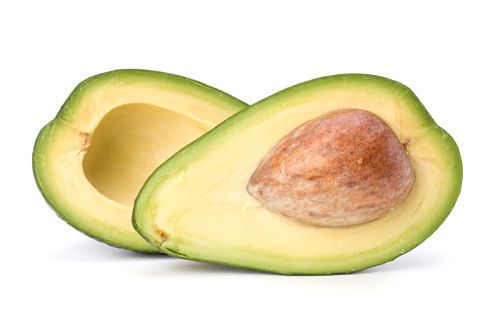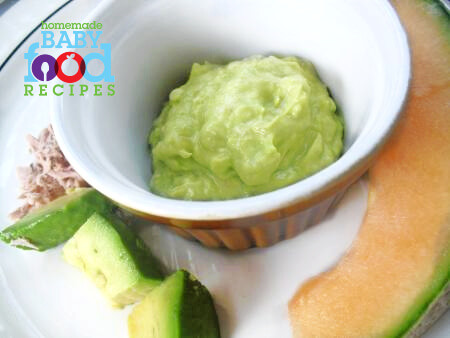Avocado Baby Food Recipes
Updated: Aug 20, 2023
These avocado baby food recipes add an array of nutrients to your baby’s diet.
Learn how to prepare nature’s ready-made baby food for your little one!
Please note: When you introduce any new foods to your baby, follow the four day rule, to help you spot potential food allergies and digestive problems.
Please remember to consult your doctor before including new foods in your baby’s diet.
Avocado Baby Food Facts
With its smooth and creamy consistency and delicate, nutty flavour, the avocado should be given the title of ‘Nature’s Baby Food’.
Not only is the taste and texture ideal for a baby food beginner, the avocado is an unrivalled, all-around, complete food for infants.
What's more, it has an impressive list of health-giving properties.
The avocado – also known as avocado pear, alligator pear (thanks to the appearance of the skin of some varieties) or butter pear – is, indeed, a fruit.
In fact, according to Wikipedia, its botanical classification is a berry!
Although it is treated as a vegetable by many people, it is eaten with milk and sugar in some cultures and is considered a ‘sweet’ item.
Clearly, the avocado is an extremely versatile food.
The avocado is native to tropical and subtropical parts of south and central America, but it’s also grown in warmer regions of America, including Hawaii, Florida and California.
The type of avocado most commonly found in your local store – the rich and creamy Hass – is mainly grown in Mexico.
Nutritional Benefits
Monounsaturated fats
Dieters often shy away from avocados.
They have a reputation as being ‘full of fat’ and – therefore – bad for you!
Although avocados have a higher fat content than most other fruits (around 20 times the amount, on average), they actually contain health-promoting monounsaturated fats.
These fats are needed by your baby’s body for the healthy development of his brain and central nervous system.
One of these fats, oleic acid, is believed to help lower cholesterol (source: The Avocado and Human Nutrition).
Potassium
Avocado is an excellent source of potassium, containing around 60% more of this valuable mineral than bananas!
Potassium help regulate blood pressure and, in later life, can help prevent heart disease, strokes and hypertension (high blood pressure).
Lutein
Lutein is a carotenoid (a nutrient in the pigment that gives certain fruits and vegetables their colour).
A natural anti-oxidant, lutein is responsible for promoting healthy skin and eyes.
Avocados also contain the following important nutrients…
|
|
The SlimCado
You may have seen the SlimCado in the produce aisle at your local store, which is marketed as a ‘lite’ avocado, with less fat.
To discover why the SlimCado is lower in fat than other avocados, visit this post on our blog.
Hidden Benefits
Not only is avocado baby food highly nutritious in its own right, avocado actually helps your baby’s body more efficiently absorb the nutrients from OTHER fruits and veggies he eats them with!
Back in 2005, an interesting article about avocado was published in the Journal of Nutrition. It revealed that tests had shown how adding avocado to salad and salsa
“…significantly enhances carotenoid absorption“
and that
“…adding avocado fruit to carotenoid-containing meals as a lipid* source can facilitate carotenoid absorption while offering additional nutritional benefits“
*Lipids – organic compounds that are necessary for healthy cell growth.
Carotenoids are soluble in fat.
Avocados are rich in monounsaturated fats, so it is believed that eating carotenoid-rich foods along with them makes the carotenoids more ‘bioavailable’ (which means that the body is able to absorb them more easily).
What more could you ask from a baby food?
No wonder the Guinness Book of Records lists avocados as the most nutritious fruit in the world!
Choosing The Perfect Fruit
Many parents prefer to buy the Hass variety when preparing avocado baby food, because it is so rich and creamy.
The Florida (Fuerte) variety is larger, with a smooth, dark green skin.
It is sometimes called the ‘dieter’s avocado’ because it is lower in fat and calories than other varieties – subsequently, it is also less rich in taste!
Avocados mature ON the tree, but ripen OFF the tree – you can test for ripeness by gently pressing the skin with your finger.
If it leaves a little ‘dent’, then the fruit is ripe.
Unless you are going to be preparing the avocado for your baby very soon after purchasing it, you might prefer to buy a slightly unripe fruit and allow it to ripen at home.
Avocados move from ripe to overripe very quickly.
On the other hand, you may have bought an unripe avocado, but then be in a hurry to have it ripen!
So how can you encourage an avocado to ripen more quickly?
Well, you can certainly speed up the process by storing it in a paper bag.
This is because fresh produce releases a gas called ‘ethylene’ into the atmosphere.
If you place an avocado into a bag, it re-absorbs the ethylene it has produced… and this acts as a stimulant to produce even MORE ethylene.
This then hastens the ripening process – and you can speed things up further still by placing ANOTHER ethylene-producing item (like a banana) in the bag, too!
Readers' Pics

First Bites! Yummy Avocado!
I LOVE this site!
I just started my little one, Django (pronounced Jane-Go) onto solid foods and am making everything at home.
Thanks to this website, IT’S SO EASY!!
Gigi – New Braunfels, TX
Basic Preparation and Storage Tips
You can store a ripe, uncut avocado in your refrigerator for up to a week.
Don’t put it in the refrigerator BEFORE it’s ripe, though, or it will fail to ripen properly.
Once cut, it will keep in the fridge for 1-2 days.
To cut an avocado, slice it in half lengthwise and twist the two halves apart.
A sharp tap with a heavy knife should help loosen the pit, making it easy to remove.
Cut avocado oxidizes and turns brown very quickly.
If you have some of the fruit left over after preparing your avocado baby food recipe, then you have a few options!
Handy tip
Why not pamper yourself with a face mask – avocado is great for the skin!
Just mash the leftovers with a little sour cream and apply to the skin (avoiding the eye area).
Leave for 15 mins, then rinse!
How can I stop avocado from turning brown?
- Store the rest of the avocado, cut side down, on a plate in the refrigerator.
- Wrap the remaining piece in food-safe plastic wrap, or a sealed Zip-Loc bag.
- Mash the avocado with a little lemon juice – please be aware that citrus juices may cause allergic reactions in some children.
- Adopt the method traditionally used in Mexico and store the avocado WITH the pit (although we find a little oxidization still occurs with this method).
- Mash or puree the leftover avocado, then freeze it in a special baby food freezer tray, or in a regular ice cube tray, covered in foil.
Frozen avocado seems to retain its bright colour quite well! - Eat it yourself (in fact, the Aztecs used to believe avocado to be a great aphrodisiac!).
Although the discolouration of an avocado is visually unappealing, it’s not harmful to eat.
If oxidization DOES occur, you can just scrape off the brown part with a knife.
When Can My Baby Eat Avocado?
For many years, infant rice cereal has been the main ‘first food’ recommended for babies.
But recommendations are beginning to change.
Many parents and some pediatricians question the nutritional value of infant rice cereal – and parents often find that it leads to constipation in their babies.
It is now being recognized that there are other nutritious foods that may be better suited to the role of ‘baby’s first food’.
Did you know…
Because they are so high in protein, avocados make an excellent alternative to meat in a vegetarian diet.
Read more – is rice cereal the best first food for baby?
Without a doubt, the avocado fits that role perfectly – and can be introduced to your baby from 6 months of age (or from 4 months if recommended by your pediatrician).
In addition to the wide range of nutritive benefits we mentioned earlier, avocados are highly digestible, are not considered to be common allergens and do not appear to cause constipation.
Due to their high calorie content, avocados are an excellent food for babies with feeding difficulties (infant reflux, for example).
Babies such as these will benefit from a generous amount of calories in a small quantity of food.
Warnings & Allergies
The pit and skin of an avocado can be toxic to pets – so please make sure you dispose of them safely.
Although allergy to avocado is rare, your baby is at an increased risk of experiencing an allergic reaction to avocado if he has a latex allergy.
It seems a strange connection – but avocados contain substances called chitinases.
These substances are associated with with the latex/fruit allergy syndrome and they increase in avocados that have been treated with ethylene gas to encourage them to ripen more quickly.
Organic avocados that have NOT been treated have a reduced allergenic potential.
If your baby has a latex allergy, you should probably avoid avocado during your baby’s first year and discuss the introduction of avocado with your child’s doctor.
Avocado Baby Food Recipes
For a nutritionally complete and tasty meal for your baby food beginner – with an ideal consistency, too – just slice open an avocado and spoon its creamy flesh straight into your baby’s mouth!
Yes, it’s as easy as that… you do not need to cook the fruit or add anything to it!
To make it more manageable for baby’s very first meal, spoon it into a bowl and mash it with a fork.
For a smoother texture still, you can puree it in a food processor.
If you are introducing avocado to your baby after the recommended age of 6 months, you shouldn’t really need to add anything to thin the consistency.
But if you DO feel the need to make it a bit more ‘soupy’, just add a little breast milk or formula as you mash or puree the fruit.
NOTE: We highly recommend avocado as an ideal food to take when you’re travelling with your baby.
An unpeeled avocado doesn’t need to be kept cool and you can just slice it and serve it to your baby when you’re out and about.
You don’t even need a bowl!
First Foods
Creamy Fruit Mash
1 apple or pear, peeled, cored and diced
1/2 avocado, peeled
little water
- Place the prepared apple or pear into a small saucepan and add a little water.
- Simmer gently until the fruit is tender.
- Transfer the apple or pear to a food processor and puree until smooth.
- Mash the avocado with the fruit puree and serve.
Melon Delight
1 small slice Cantaloupe melon
1/2 avocado, peeled
- Remove the skin from the melon, then simply mash the avocado and melon together.
- This tastes wonderful with a touch of ground ginger!
Sweet Potato and Avocado Dinner
1 small sweet potato
1 avocado, peeled
- Bake the sweet potato in its skin for 45 mins – 1 hour until tender.
- Cool, then remove the flesh from the skin and mash with the avocado.
- Avocado also tastes delicious mashed with cooked butternut squash.
You may also like:
Black Bean and Brown Rice Dinner with Avocado and Apple – a complete protein baby food recipe
No-Cook Fruity Treat
1 small, ripe banana
1 avocado
- Peel both fruits and mash together for a creamy treat for your baby that’s ready in a flash!
More Advanced Avocado Recipes
Here are some more ways in which you can prepare avocado for baby – please note that the tannin in avocado can cause it to become a little bitter when cooked.
If you wish to include avocado in a cooked dish, add it right before serving.
Tropical Treat (6 months+)
1/2 avocado, diced
1/2 small banana, sliced
1/2 papaya, peeled and diced
1/2 kiwi, peeled and sliced
2oz (1/4 cup) unflavoured natural yogurt
drop of pure Maple Syrup (optional)
- Combine all the fruits in a bowl. (If this recipe is to be used for a young baby, you can puree the fruit at this stage).
- Top the fruit with the yogurt (you can stir in a little Maple Syrup if you wish) and serve.
Readers' Pics

Hannah loves her sweet-treat breakfast!
I made the the Tropical Treat recipe for my grandchildren and it was so good – the whole family had it for breakfast!
We all loved it and I didn’t tell the “big kids” it was nutritious either!
Connie – Bloomsburg, PA, USA
Baby Guacamole (8 months+)
1 avocado
1/2 fl oz tomato juice
little fresh coriander (cilantro), chopped
little ground cumin
- Mash the avocado, then stir in the remaining ingredients and serve as a dip.
Tofu and Avocado Cream (8 months+)
This recipe makes a great dip to accompany finger foods, or can be used as a nutritious spread.
1 avocado, diced
4oz (1/2 cup) silken tofu
4oz (1/2 cup) natural yogurt
1 tbsp chopped, fresh chives
- Simply mash and puree all the ingredients together, chill… and serve!
Banana and Kiwi With Creamy Fruit Dressing (6 months+)
1/2 ripe banana, sliced
1/2 ripe kiwi, sliced
1/2 avocado, diced
1oz (1/8 cup) cream cheese
pineapple juice
- Arrange the sliced banana and kiwi in a bowl (or puree together for younger babies).
- Combine the avocado and cream cheese, then add enough pineapple juice to achieve a spoonable consistency.
- Top the fruit with the creamy avocado dressing.
Baked Potato With Avocado Topping (6 months+)
1 medium white potato
1/2 avocado, mashed
2oz (1/4 cup) natural yogurt
1tsp fresh chives, chopped
- Bake the potato in its skin for 1 – 1 1/2 hours at 375 deg F (don’t forget to prick it first).
- Mix the avocado with the yogurt.
- Split the potato and top with the avocado mixture.
- Sprinkle with the chives, allow to cool… and serve!
Gourmet Sandwich Spread (6 months+)
1/2 avocado
1/2 small roasted red pepper
1oz (1/8 cup) hummus
- Combine all ingredients for a divine sandwich spread that will please not just your discerning little diner… but the rest of the family, too!
Simple Avocado Soup (6 months+)
6 fl oz (3/4 cup) homemade vegetable stock
1 ripe, peeled avocado
2 fl oz (1/4 cup) milk (you can use breast milk or formula)
a little fresh coriander (cilantro), chopped
- Warm the vegetable stock, then stir into the mashed avocado.
- Add the milk and stir well, then sprinkle with the coriander.
No Cook Baby Food…
You may also like to try mashing avocado with cooked egg yolk for a simple meal brimming with goodness…
Click here for more information about including eggs in your baby’s diet.
Finger Food Ideas
Avocado makes a wonderful finger food for baby.
It’s soft enough to be easily gummed by a toothless infant and needs very little preparation – just cut it into manageable slices.
The only problem with avocado as a finger food is that it can be VERY slippery – almost like soap!
Try coating pieces of avocado with crushed cereal (like Cheerios) or wheat germ (which will add extra nutrients).
Both will help your baby get a better grip!
A Parent’s tip!
One of our visitors told us that she likes to cut slippery fruits and veggies for her little one with a Crinkle Cutter. The ridges help him hold on to the foods more easily! We think this is a great idea!More Finger Food Ideas
- Mash a nice, ripe avocado and offer it as a dip to accompany veggies or fruits.
- Mash egg yolks with avocado and use as a sandwich filling.
- Mash it thoroughly and spread it straight on to a lightly toasted bagel or toasted bread strips.
Avocado makes a VERY healthy alternative to mayonnaise as your child grows, so it’s a good idea to introduce the concept of avocado as a sandwich spread as early as you can. - Add diced avocado to scrambled eggs (see this page for more information about introducing eggs) and give to your baby in a bowl to eat with his fingers.



